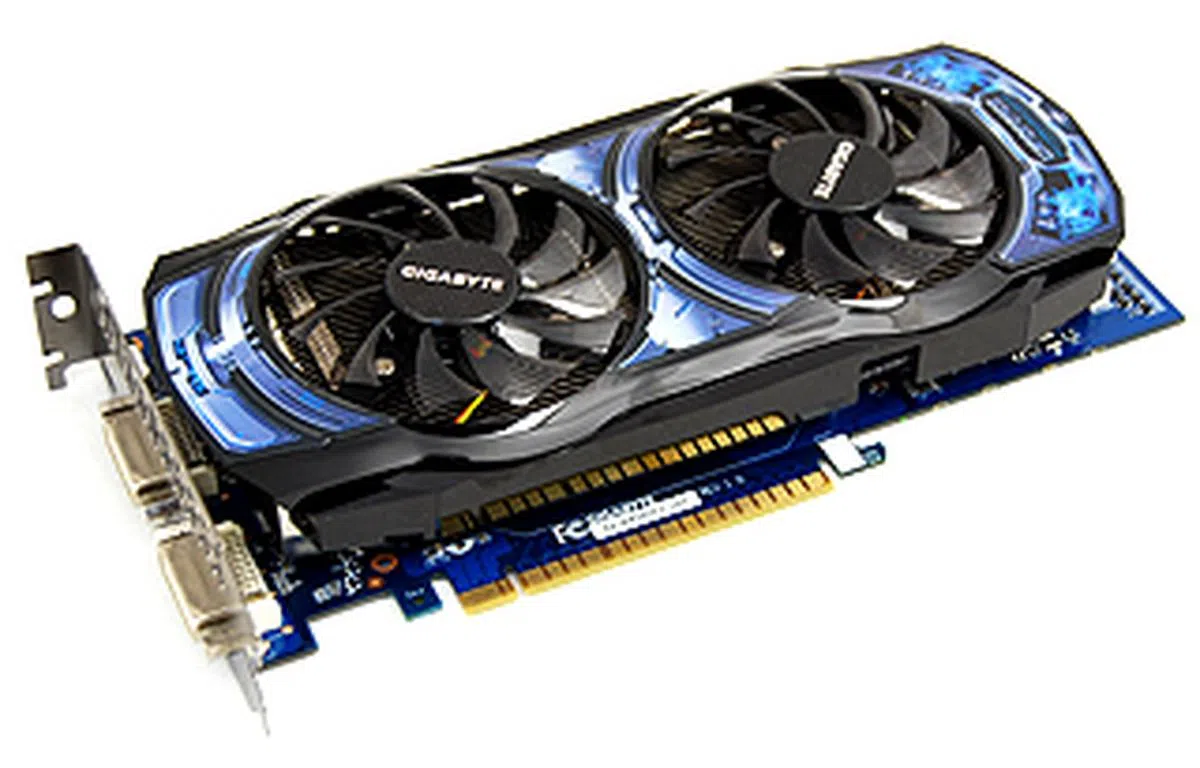GeForce GTS 450 Roundup Part 2 - New Additions Reviewed
It's been a month since the launch of the GeForce GTS 450 and NVIDIA's partners have come up with more custom editions. Today, we take a look at the five newest to hit the market from ECS, EVGA, Gigabyte, Leadtek and last but not least, Palit's ultra-compact card.
By Kenny Yeo -
New Additions Reviewed
Launched slightly more than a month ago, the GeForce GTS 450 was introduced as NVIDIA’s graphics solution for mainstream gamers. Priced at a palatable US$129, the GeForce GTS 450 packs an all-new GF106 chip that was specifically designed to tackle the popular 1680 x 1050 resolution. And as we found out in our intial review and roundup , it’s a pretty handy card.
A quick refresh if you’ve already forgotten. The GeForce GTS 450 packs 192 CUDA cores, 32 texture mapping units and 16 raster operating units, complemented by 1GB of GDDR5 framebuffer over a 128-bit wide memory bus. Priced to compete against the Radeon HD 5750, it handily beats its ATI rival by around 5% to 15% across our benchmarks, so in that sense, it’s a rather decent offering from NVIDIA. We also found that custom, factory-overclocked versions of the GeForce GTS 450 are almost on a par with the Radeon HD 5770.

The GeForce GTS 450 is not groundbreaking, but it's a decent choice for mainstream and casual gamers to get in on some DirectX 11 gaming action.
A month after its launch, there’s now a wide variety of custom-designed GeForce GTS 450 cards from NVIDIA’s partners, and in this article, we cover five more offerings from ECS, EVGA, Gigabyte, Leadtek and Palit. Here's the full list of cards in this roundup:
- ECS GTS 450 Black
- EVGA GeForce GTS 450 FTW
- Gigabyte GeForce GTS 450 OC
- Leadtek WinFast GTS 450 Extreme
- Palit GeForce GTS 450 Low Profile
The ECS GTS 450 Black
Like the ECS GTX 460 Black we’ve previously reviewed, the GTS 450 Black keeps up with the Black tradition by offering a massive triple-slot, dual-fan cooler from aftermarket cooling specialists Arctic Cooling. To make the most of the cooler, the card comes factory overclocked, running at 850MHz at the core, 1700MHz at the shaders, and 4000MHz DDR at the memory.

This is the second custom GeForce GTS 450 we've seen to make use of Artic Cooling's whopping Accelero Twin Turbo Pro cooler.

The ECS card gets the usual twin DVI ports and single HDMI port for video output.

The custom cooler is massive and unlike Sparkle's implementation, the one here gets the full four copper heat pipes.
The EVGA GeForce GTS 450 FTW
The EVGA GeForce GTS 450 FTW may very well be the “sleeper” of the group, because despite sporting a reference-looking cooler, this card sports one of the highest clock speeds - 920MHz at the core, 1840MHz at the shaders and 4100MHz DDR. It’s 10MHz and 20MHz down the on core and shader clock speeds compared to the Palit GeForce GTS 450 Sonic Platinum, the quickest GTS 450 we’ve tested so far, but it has a 100MHz DDR advantage when it comes to memory; will it be enough? We’ll soon find out.

Don't let its looks fool you, the EVGA GeForce GTS 450 FTW sports one of the highest clock speeds of any GeForce GTS 450 card.

The usual twin DVI and single HDMI ports here.

The cooler is identical to the one seen on reference GeForce GTX 460 cards.
The Gigabyte GeForce GTS 450 OC
Confusing, Gigabyte offers two overclocked variants of the GeForce GTS 450 and although both cards are fitted with Gigabyte’s anti-turbulence Windforce 2X coolers, one is more extreme than other. Ours happens to be the more extreme and faster of the two and it sports a core clock speed of a staggering 930MHz, whereas its shaders and memory are clocked at 1860MHz and 4000MHz DDR respectively, which are similar to the Palit GeForce GTS 450 Sonic Platinum.

The Gigabyte GeForce GTS 450 OC comes with the recognizable Windforce cooler.

No surprises here, the Gigabyte comes with two DVI ports and a single HDMI port.

The fans are slightly angled to reduce turbulence for smoother air flow.
The Leadtek WinFast GTS 450 Extreme
The Leaktek WinFast GTS 450 Extreme sports a funky cooler and on a retro green PCB, and despite the “Extreme” tag in its name, its clock speeds is actually relatively tame. 850MHz at the core, 1700MHz at the shaders and 3608MHz DDR is a significant bump up from reference clock speeds, but when compared to speedsters like the Gigabyte and EVGA card, it does pale a little.

The cubic/carbon fiber prints on the custom cooler is a bit of the mismatch with the retro green PCB.

For video output options, choose from twin DVI ports or a single HDMI port.

The heatsink underneath is a mixture of copper heat pipes and aluminium cooling fins.
The Palit GeForce GTS 450 Low Profile
The Palit GeForce GTS 450 Low Profile is not company’s first custom designed GeForce GTS 450, but rather than overclock it and put on a massive cooler, Palit has instead headed in the opposite direction. As you can see, the Palit GeForce GTS 450 is tiny compared to the other cards in this roundup. It also retains NVIDIA’s reference clock speeds of 783MHz at the core, 1566MHz at the shaders and 3608MHz DDR at the memory. If the card delivers, this could be the most powerful small form factor HTPC graphics card you could ever lay your hands on.

Look at how small the Palit GeForce GTS 450 Low Profile is compared to massive gargantuan ECS GTS 450 Black.

Because of its small form factor, there's only a single DVI and HDMI port.

Key to the card's small size is the redesigned fans of the cooler featuring what Palit calls "skived fins".
Test Setup
The cards will be tested using our usual Intel X58 platform which has the following specifications:
- Intel Core i7-975 (3.33GHz)
- Gigabyte GA-EX58-UD4P motherboard
- 3 x 1GB DDR3-1333 G.Skill memory in triple-channel mode
- Seagate 7200.10 200GB SATA hard drive
- Windows 7 Ultimate
Clock speeds are often an accurate gauge of a card’s outright performance and with that in mind, we predict a close fight for supremacy between the EVGA GeForce GTS 450 FTW and Gigabyte GeForce GTS 450 OC, both of which have very high and competitive clock speeds. While the two battle for honors, the ECS GTS 450 Black and Leadtek WinFast GTS 450 Extreme should prove to be competitive too, seeing their comparable clock speeds. The ultra-compact Palit GeForce GTS 450 Low Profile sports reference clock speeds so in terms of performance, it’s definitely out of the running. However, that card was obviously not meant for the regular gamers but HTPC enthusiasts in need of good gaming grade card.
To spice things up, we’ve also included results from our previous . Here’s a summary of the five cards’ clock speeds.
Cards | Core Clock Speed | Shader Clock Speed | Memory Clock Speed |
ECS GTS 450 Black | 850MHz | 1700MHz | 4000MHz DDR |
EVGAGeForce GTS 450 FTW | 920MHz | 1840MHz | 4100MHz DDR |
Gigabyte GeForceGTS450 OC | 930MHz | 1860MHz | 4000MHz DDR |
Leadtek WinFast GTS 450 Extreme | 850MHz | 1700MHz | 3600MHz DDR |
Palit GeForceGTS 450 Low Profile | 783MHz | 1566MHz | 3608MHz DDR |
The full list of cards tested and the driver versions used:
- ECS GTS 450 Black (ForceWare 260.52)
- EVGA GeForce GTS 450 FTW (ForceWare 260.52)
- Gigabyte GeForce GTS 450 OC (ForceWare 260.52)
- Leadtek WinFast GTS 450 Extreme (ForceWare 260.52)
- Palit GeForce GTS 450 Low Profile (ForceWare 260.52)
- Galaxy GeForce GTS 450 Super OC (ForceWare 260.52)
- MSI N450GTS Cyclone (ForceWare 260.52)
- Palit GeForce GTS 450 Sonic Platinum(ForceWare 260.52)
- Sparkle Calibre X450G(ForceWare 260.52)
- ATI Radeon HD 5770 (Catalyst 10.8)
The full list of benchmarks used:
- Futuremark 3DMark Vantage
- Crysis Warhead
- Far Cry 2
- Warhammer: Dawn of War 2
- Battlefield Bad Company 2
- "Heaven" from Unigine v2.1
- S.T.A.L.K.E.R.: Call of Pripyat
3DMark Vantage
Beginning with the usual 3DMark Vantage, we weren’t surprised to see both the EVGA and Gigabyte cards scoring similarly high scores. Both cards were extremely competitive, but the Gigabyte card did take a slight lead on the Extreme preset. Elsewhere, the ECS and Leadtek cards were equally competitive and as we predicted, the low profile Palit card racked up the lowest scores.

Crysis Warhead & Far Cry 2 Results
Expectedly, the EVGA and Gigabyte cards were once again neck and neck, recording nearly identical frame rates. It was the same story too for the ECS and Leadtek cards, although not to the same extent, as we can see that the ECS card was just a smidge quicker thanks to its faster clocked memory. Nevertheless, the margin is very slight and the difference was only a frame at most. Again, the compact low profile Palit card rounded up the pack with its reference clock speeds.
A point worth noting is that despite the EVGA and Gigabyte cards’ aggressive clock speeds, they were only able to match a reference Radeon HD 5770 and not surpass it.


On Far Cry 2, it was once again a tough fight between the EVGA and Gigabyte cards. It seems that whatever deficit the EVGA has in core clock speeds is made up for by its faster clocked memory. The ECS and Leadtek cards was once again very comparable, and the low profile Palit card, because of its reference clock speeds, was the slowest of the lot.


Dawn of War 2 & Battlefield Bad Company 2 Results
On Dawn of War 2, EVGA and Gigabyte cards was once again inseparable in terms of performance. From the graphs, we can see that ECS card was marginally quicker than the Leadtek card, but in reality the difference was only about 1% to 2%. Again, the reference clocked low profile Palit card rounded up the pack. With its reference clock speeds, it’s simply no match for the other factory overclocked cards.

It’s more of the same on Battlefield Bad Company 2, with the EVGA and Gigabyte cards still inseparable in terms of performance. It was a close fight between the ECS and Leadtek cards too, although the ECS card can be said to be marginally quicker.

Unigine "Heaven" 2.1 Results
Again, the EVGA and Gigabyte cards were also competitive than they recorded nearly identical frame rates. It was simply impossible to pick a winner between the two of them. The ECS and Leadtek cards were equally competitive as well, as the difference between them was barely a single frame. NVIDIA’s Fermi cards have traditionally performed well when tessellation comes into play and this is evidenced by the cards superior performance when compared to a reference Radeon HD 5770.


S.T.A.L.K.E.R.: Call of Pripyat Results
Finally, coming to S.T.A.L.K.E.R.: Call of Pripyat, the aggressively overclocked EVGA and Gigabyte cards were once more locked head to head in combat and both recorded frame rates that were almost identical. It was the same story too for the ECS and Leadtek cards, this despite the ECS gaining a 400MHz DDR advantage on memory clock speeds compared to the Leadtek card. Again, we see the superiority of the Fermi architecture compared to the older Radeon HD 5770 when it came to tessellation applications.
DirectX 11 Results
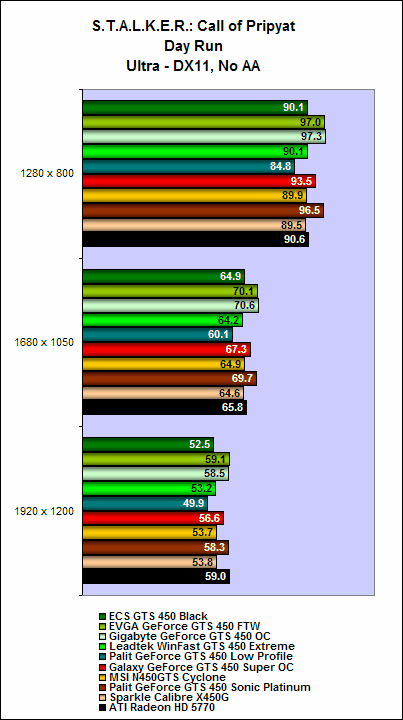 | 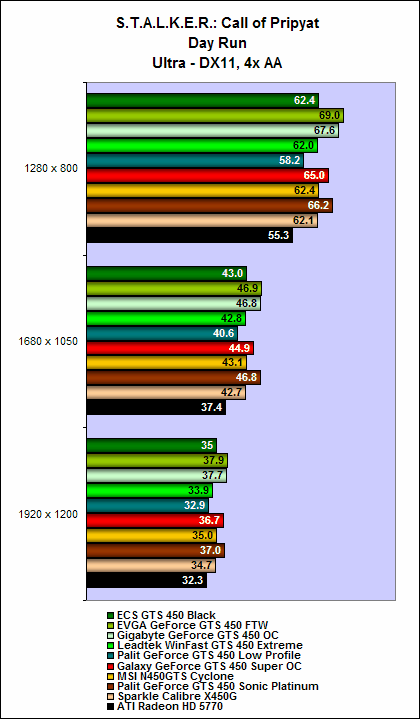 |
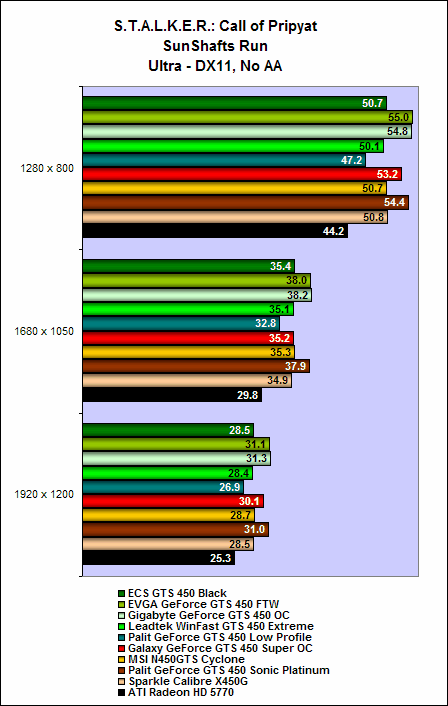 | 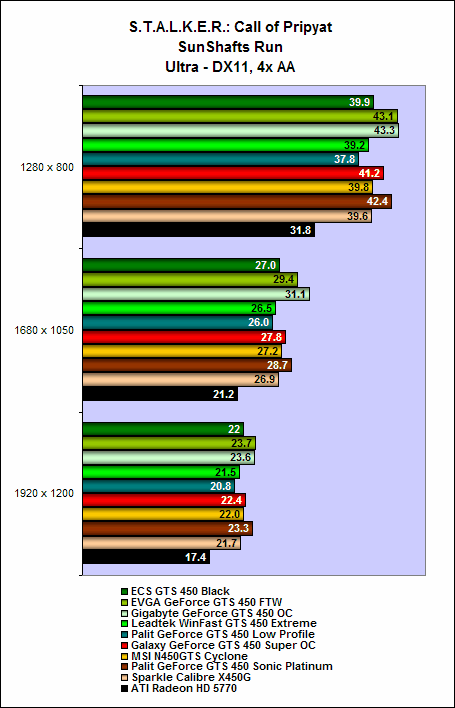 |
Temperature
It is often said that size doesn’t matter, but it’s apparent in our temperature testing that sometimes does hold true. As our graphs show, the ECS GTS 450 Black with its massive custom cooler from Arctic Cooling recorded a scarcely believable 39 degrees Celsius. In comparison, the other four GeForce GTS 450 that we have rounded up all recorded above 60 degrees Celsius. And the low profile Palit card with its compact candy bar cooler, recorded the highest temperature of 77 degrees Celsius.

Power Consumption
Power readings of all five cards were more or less inline with our expectations. Although all cards recorded comparable readings at idle, the Gigabyte GeForce GTS 450 OC stood out for its slightly higher than average reading at load, which is not entirely surprisingly given its high clock speeds. In the same vein, the reference clocked Palit GeForce GTS 450 Low Profile recorded the lowest power draw readings at load amongst all the GeForce GTS 450 cards.

Overclocking
The GF106 chip is an eager overclocker and our collection of cards did admirably in our overclocking tests, and taking top honors was the ECS GTS 450 Black. With its massive cooler and cool operating temperature, we managed to run the ECS GTS 450 Black stably at a full 1000MHz at the core and 4400MHz DDR at the memory. This gave us a considerable 5561 3DMarks, an improvement of 16%.
Another noteworthy mention was the EVGA card, because despite sporting a simple, reference-looking cooler, the card was able to run comfortably at 990MHz at the core and 4200MHz DDR, recording 5451 3DMarks in the process.
Seeing that the low profile Palit card recorded the highest operating temperatures in our earlier temperature test, it wasn’t surprising to find that it only managed 930MHz at the core and 4000MHz DDR. It’s some ways off the mark compared to the other cards, but all things considered, its actually a decent result for a low profile, half-height card.

To Each His Own
Overall, the performances of the cards were pretty much what we expected with the EVGA and Gigabyte cards turning out to be the quickest, followed by the ECS and Leadtek duo, and finally the low profile Palit card. But before we offer our analysis of the individual cards, here’s a quick summary of the card’s clock speeds and price.
Cards | Core Clock Speed | Shader Clock Speed | Memory Clock Speed | Price |
ECS GTS 450 Black | 850MHz | 1700MHz | 4000MHz DDR | ~US$150 |
EVGAGeForce GTS 450 FTW | 920MHz | 1840MHz | 4100MHz DDR | US$147 |
Gigabyte GeForceGTS450 OC | 930MHz | 1860MHz | 4000MHz DDR | US$149 |
Leadtek WinFast GTS 450 Extreme | 850MHz | 1700MHz | 3600MHz DDR | US$135 |
Palit GeForceGTS 450 Low Profile | 783MHz | 1566MHz | 3608MHz DDR | US$129 |
Cards | Performance | Features | Value | Overall |
ECS GTS450 Black | 9.0 | 8.5 | 8.0 | 8.5 |
EVGAGeForce GTS 450 FTW | 9.0 | 8.0 | 7.5 | 8.5 |
Gigabyte GeForceGTS 450 OC | 9.0 | 8.5 | 8.0 | 8.5 |
Leadtek WinFast GTS 450 Extreme | 8.5 | 8.5 | 8.0 | 8.5 |
Palit GeForce GTS 450 Low Profile | 7.5 | 9.0 | 8.0 | 8.5 |
The EVGA GeForce GTS 450 FTW is really a wolf in sheep’s clothing, because despite its stock-looking cooler, it actually sports one of the most aggressive clock speeds. Hence as far as performance is concerned, it is first rate, along with the Gigabyte card. However, that has come at a cost to operating temperatures as it was one of the hottest GeForce GTS 450 cards that we’ve tested. And at US$147, we don’t think it’s really good value for money either.
Why? Because the Gigabyte GeForce GTS 450 OC, which is as quick as the EVGA card, costs only a tad more at US$149. And between the two, the Gigabyte card is the one we would go for because it also sports Gigabyte’s Windforce 2x cooler, which we found to be rather effective.
The ECS GTS 450 Black is an intriguing proposition considering its massive cooler from Arctic Cooling, which allowed it to record not only the lowest operating temperatures, but also achieve the highest overclocking state. It many ways then, it closely resembles the previously reviewed Sparkle Calibre X450G, since the latter also sports a similar cooler from Arctic Cooling. Although we couldn’t get the exact price at the time of writing, the custom cooler, as we understand, costs around US$40 on its own so we would expect the ECS card to retail around the US$150 mark. This makes it a bit pricey considering its performance, but the cooler is very effective and quiet, so if a cool card is your priority, then this might just be the card for you.
The Leadtek WinFast GTS 450 Extreme is a quick card, and offers substantial improvements in performance when compared to a bone stock GeForce GTS 450. It’s about as fast as the ECS GTS 450 Black, but loses out slightly because of its lower memory clock speeds. Furthermore, at US$135, it’s the cheapest custom designed GeForce GTS 450 we’ve reviewed and all things considered, it offers the best bang for buck if you are not too concerned about having the quickest card.
The Palit GeForce GTS 450 Low Profile is an interesting card, because despite its average performance (no thanks to reference clock speeds) it is impossibly small even for a mainstream card. Kudos to Palit for squeezing a GF106 into such a compact and tiny form factor, which will easily fit SFF systems and HTPCs. Coupled with the GeForce GTS 450’s modest power requirements, this Palit card offers the best graphics horsepower to size ratio. Only our concern is the slightly higher than average operating temperatures, but we guess that’s unavoidable given its small size. Nevertheless, its small size makes it the most interesting GTS 450 in our roundup.
Overall, the cards performed up to our expectations and each has its own appeal. That said, if you are only interested in outright speed, our recommendation is the cooler to run Gigabyte GeForce GTS 450. The ECS and Leadtek cards are pretty evenly matched in our books, but the Leadtek gains a slight advantage because of its cheaper price. And if you are looking for a powerful mainstream card to power your SFF or HTPC, the Palit GeForce GTS 450 Low Profile is an excellent choice.
<img height="205" width="320" src="https://cassette.sphdigital.com.sg/image/hardwarezone/fd905ded58b6566258e10bd0f1dfe2e52de1bbfe262951e18dfc807a3c811544" title="The Palit GeForce GTS 450 Low Profile " class="caption" alt=""> | 
|
<img height="234" width="320" src="https://cassette.sphdigital.com.sg/image/hardwarezone/927573e266837a8a3d2a197a6e52edfcc435389c5670cca681ee713f6a742b56" title="The ECS GTS 450 Black " class="caption" alt=""> | |
<img height="213" width="320" src="https://cassette.sphdigital.com.sg/image/hardwarezone/29ee2f2d631e3f016462ae23b1f49a021a032578678ac697542aff0f5f408034" title="The EVGA GeForce GTS 450 FTW " class="caption" alt=""> |  |
|  |
<img height="228" width="320" title="The Leadtek WinFast GTS 450 Extreme
" src="https://cassette.sphdigital.com.sg/image/hardwarezone/b7b844cc7715a28b4ac58bec2fff4f401006d815a153f14fd0b73ccf99d4b827" alt=""> |  |
Our articles may contain affiliate links. If you buy through these links, we may earn a small commission.
